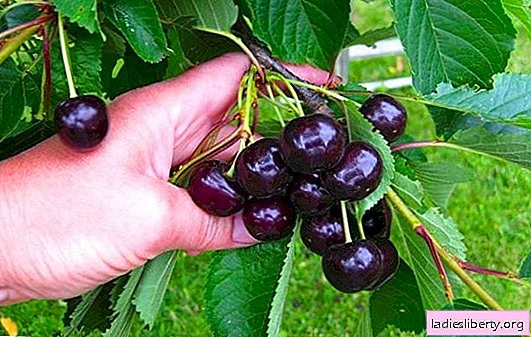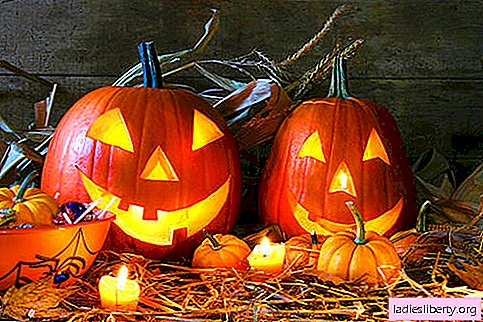
Cherry is one of the popular garden crops.
The inhabitants of our country have known her for about 200 years.
Once the southern culture, thanks to the work of breeders, now pleases with its harvest not only the inhabitants of the southern regions.
Her cultivation became possible in colder areas.
Cherry received universal recognition thanks to its unusually tasty and healthy berries.
The best varieties of cherries for the middle strip
The culture is famous for its great variety variety. But not every variety of it is possible to cultivate in this strip of Russia. For this region, special varieties are developed that tolerate climatic features. All cultivated varieties of this latitude are divided into 3 groups according to the vegetative period.
Early ripe varieties. Harvesting their fruits begins in the second half of June. They are juicy and fragrant, have a good taste. The best early varieties of cherries for this region are: Iput, Yellow Farmhouse, Ovstuzhenka, Orlovskaya, Krasnaya Gorka, Raditsa.
Iput. Medium-sized sweet cherry, with a wide pyramidal crown. Flowering begins in mid-May. The berries are dark red, easily separated from the stem, large. The pulp is dense, tastes juicy and sweet. A high-yielding variety of cherries, you can collect up to 35 kg of berries from one tree. Among the advantages of the variety, its resistance to frost, fungal diseases and pests also stands out. Begins to bear fruit only after 5 years. With an excess of moisture, the fruits begin to crack, their taste deteriorates.
"Sheepskin". The tree is low, with a dense spherical crown. The cherry blossoms in early May. The variety is distinguished by large and very tasty berries, but you can enjoy them only after 5 years. They are rounded, dark red (closer to black). The pulp is juicy, but not dense, fibrous. The stone is small and can be easily separated from the pulp. Sweet cherry has high frost resistance, stable yield and is not susceptible to pests and diseases.

(grade "Ovstuzhenka")
Mid-season grades. Fruit ripening begins in mid-summer. The best mid-ripening varieties are considered to be Mid-ripe Revna, Adeline, Beauty, Fatezh, Leningradskaya Rosova, Pobeda.
Adeline. Medium-sized tree up to 3-4m high, with a spreading pyramidal crown. The first berries appear from mid-July, have a heart-shaped shape. They are large (each weighs up to 6g), dark red with pulp of the same color. She is not dense, with red juice. The stone is small and easily separated from the pulp. This variety has good winter hardiness. The first fruiting begins after 4 years. A minor drawback is the average pest resistance and average yield.
"Victory". The tree is tall with a sprawling but sparse crown. Already in early July, large (up to 7g) dark crimson fruits ripen on it. They are very juicy, tasty (sweet with a slight acidity). The pulp is tender and dense, with a small, well-taken out bone. "Victory" is famous for its high frost resistance. The variety does not belong to high-yielding species, and the first fruits can be obtained only in the 5th year. The variety is not self-pollinating and easily exposed to fungal diseases.

(variety "Victory")
"Beauty". The tall cherry tree forms a pyramidal shape with a spreading sparse crown. It blooms, like all mid-season varieties, in early May. In early July, you can enjoy its first fruits with a golden red blush. They are large, the weight of each berry is about 8g. The pulp of the fruit has a creamy tint. The bones are small and well separated from the pulp. You can evaluate the taste of the first berries after 4 years. An adult cherry tree can produce up to 20 kg of berries per season.
Late ripening varieties. Ripening of late varieties of cherries occurs in late August. The best late-ripening varieties include: "Veda", "Late-ripening jealousy", "Michurinka", "Tyutchevka", "Bryanochka".
"Bryanochka." A medium-sized variety of cherries, the height of the tree does not exceed 3.5 m. The flowering period falls at the end of May. It has large, heart-shaped, dark red fruits with dense pulp. They easily come off the peduncle. The fruit is a small bone. It is well removed from the pulp. Active ripening of the variety begins in late July. The fruiting period begins on the 5th year. It has high winter hardiness (can withstand temperatures drop to -30C), productivity. The variety is resistant to coccomycosis, but resistance to moniliosis is small.
"Michurinka". According to gardeners, this variety is one of the best late types of cherries in this strip. The height of the tree reaches 3.5m. Its crown is slightly raised, roundish, of medium density. Like all later varieties, blooms late. Fruits are rounded, medium in size, dark red. The berries taste sweet-sour with a juicy, dense pulp. The high-yielding and winter-hardy variety has an average susceptibility to diseases.

(grade "Michurinka")
This is only a small part of the best varieties of cherries that bear fruit well in the middle lane. Each of these varieties is tested and evaluated by gardeners. With proper care, the cherry will thank you with a good harvest and tasty berries.
The best varieties of cherries for the southern regions
Cherries come from the southern regions. It easily tolerates typical climatic conditions and bears fruit well. The number of cultivated varieties is striking in its diversity.
According to the ripening dates, the cherry is divided into varieties:
• very early;
• early.
The best varieties of cherries are very early ripening
"Ruby early" Differs in regular high productivity. Resistant to winter temperature changes. It has small fruits with an average weight of about 3.5g. They come in two forms: round or oval-round. Red pulp has a delicate, sweet-sour taste. Ripening early, the first berries can be enjoyed from mid-May.
"Early pink" Bred for a long time specifically for cultivation in this region. It is well adapted and easily tolerates all climatic anomalies. Fruits may be medium in size or larger. Their weight reaches 7g. They are creamy yellow in color with a pale pink blush, round or flat round. The white pulp is juicy, tender, with a pleasant acidity. The variety is resistant to diseases and pests.
"Early Krasnodar". It tolerates local winters with temperature fluctuations. It shows good yields even in hot and dry summers. The fruits are small, rounded, weighing up to 5g. Their pulp with a pleasant delicate aroma, sweet, not dense. Fruiting begins in early June.

(grade "Early Krasnodar")
Early ripe varieties of the southern region
"Valery Chkalov". Despite the fact that the variety of cherries was bred at the beginning of the XX century, it remains popular until now. The tree is winter-hardy, it is resistant to direct sunlight. Fruits are heart-shaped, red, large enough (reach a weight of up to 9g). Their dense, red flesh is sweet and sour with a noble aroma. The taste of berries depends on weather conditions. If fruit ripening coincides with hot and dry weather, then they are juicy and sweet. But in cool and rainy weather, the berries lose their sweetness, acidity appears. Fruiting begins in early June.

(Variety "Valery Chkalov")
"Les." This variety has a consistently high yield. Even with a young tree under adverse climatic conditions, gardeners manage to get high yields. The fruits are large (mass reaches 8g). They have a heart-shaped shape, close to black in color. The pulp is sweet, with a slight acidity, dark red, dense. Active ripening of berries begins in the first days of June. Their taste is not affected by weather conditions. Berries do not crack from an excess of moisture. The variety has medium resistance to pests and diseases.

(grade "Lesya")
May black. It differs in early flowering and fruiting. After 3 years, you can get the first crop. The variety is high-yielding. From an adult tree, gardeners can get up to 80 kg of berries per season. Fruits are not large, with a well detachable seed. The berries are flat-round, tasty and juicy. The variety is not afraid of pests and diseases. The disadvantage is poor transportability.
Many varieties have been developed and adapted by breeders for this region. The best varieties of cherries intended for cultivation in the southern regions are: Krasa Kuban, Black Dyber, velvet, Goryanka, Yaroslavka, Golubushka. There are about 30 sweet cherries on this list. Their resistance to weather conditions, taste characteristics are checked for years.
The best varieties of cherries for the northern regions
Thanks to the work of breeders, it became possible to grow cherries in the northern regions. The variety of its zoned varieties is not as great as in other regions. The best varieties of cherries are: "Baby", "Denis yellow", "Early mark", "Poetry", "Diana", "Chermashnaya". These varieties are not afraid of frost and are well adapted to the characteristics of the local climate.
"Denis is yellow." The variety is well adapted to the local climate. It withstands spring frosts well, and the fruits have time to ripen in a short summer. Sweet cherry has a good yield, resistant to pests and diseases. Fruits only for 5-6 years. The fruits are medium in size, have a good taste, have a juicy pulp. Berries are well stored and tolerate transportation, suitable for technical processing.

(grade "Denis yellow")
"Early mark". The variety is quite productive and winter-hardy. Trees are low, bearing fruit from 6 years. Fruits are dark red, below average size, with good taste characteristics. The stone is small, easily separated from the pulp. Berries are not suitable for processing and are consumed only fresh. The variety has medium resistance to diseases and pests.
Almost all cultivated cherries are self-fertile. To get a crop, gardeners need to plant several of its trees that have approximately the same flowering time. All varieties are photophilous, do not like waterlogging and are demanding on the soil.
According to American psychologists, cherries affect the character of a person. Fans of this culture are distinguished by a kind and gentle nature, responsiveness.











